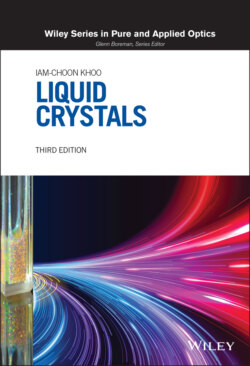Читать книгу Liquid Crystals - Iam-Choon Khoo - Страница 36
2.3.1. Maier–Saupe Theory: Order Parameter Near Tc
ОглавлениеFollowing the formalism of deGennes, the interaction energy may be written as
(2.12)
The total free enthalpy per molecule is therefore
(2.13)
where Gi is the free enthalpy of the isotropic phase. Minimizing G(p, T) with respect to the distribution function f, one gets
(2.14)
where
(2.15)
and the partition function z is given by
(2.16)
From the definition of , we have
(2.17)
The coupled Eqs. (2.15) and (2.17) for m and S may be solved graphically for various values of U/KBT, the relative magnitude of the intermolecular interaction to the thermal energies. Figure 2.2 depicts the case for T below a temperature Tc defined by
(2.18)
Figure 2.2 shows that curves 1 and 2 for S intersect at the origin O and two points N and M. Both points O and N correspond to minima of G, whereas M corresponds to a local maximum of G. For T < Tc, the value of G is lower at point N than at point O; that is, S is nonzero and corresponds to the nematic phase. For temperatures above Tc the stable (minimum energy) state corresponds to O; that is, S = O and corresponds to the isotropic phase.
The transition at T = Tc is a first‐order one. The order parameter just below Tc is
(2.19)
It has also been demonstrated that the temperature dependence of the order parameter of most nematics is well approximated by the expression [9]:
Figure 2.2. Schematic depiction of the numerical solution of the two transcendental equations for the order parameter for T ⩽ Tc; there is only one intersection point (at the origin).
(2.20)
where V and Vc are the molar volumes at T and Tc, respectively.
In spite of some of these predictions, which are in good agreement with the experimental results, the Maier–Saupe theory is not without its shortcomings. For example, the universal temperature dependence of S on T/Tc is really not valid [10]; agreement with experimental results requires an improved theory that accounts for the noncylindrical shape of the molecules [8]. The temperature variation given in Eq. (2.20) also cannot account for the critical dependence of the refractive indices. Nevertheless, the Maier–Saupe theory remains an effective, clear, and simple theoretical framework and a starting point for understanding nematic liquid crystal complexities.
